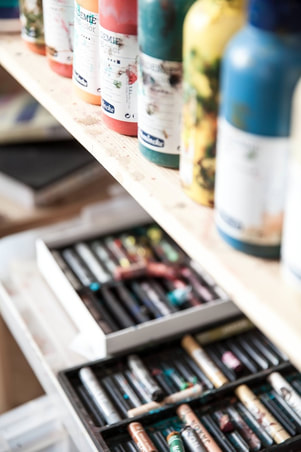How to support your child or adolescent attend therapy?Children and young people (under the age of 16) attending therapy need to be accompanied by a responsible adult, who remains in the building for the entire duration of their sessions. This applies to both in person or online therapy, the child or young person will always need to have a responsible adult in the building during the whole duration of their sessions. This is for various reasons, for example:
|
|
Over the years, as an art psychotherapist, I have seen many children and young people for therapy. The way that they are supported in attending their sessions can have a great impact on the way they engage in their sessions. I have noticed that by talking through these ideas with their parents and carers, not only were children arriving and leaving their sessions calmer but also they were in a better place to engage in their own therapeutic process. Sometimes, in leading on or following their appointments, children can even open up to talk with their parent or carer about what has been on their mind. I hope these suggestions are helpful for you to support your child or adolescent in making the most of their therapy work. |
How your role is important
|
Whether this is for online art therapy or in person, attending therapy can be quite anxiety provoking. Especially in the first few sessions when the client is developing trust and a positive relationship with the therapist- known as the Therapeutic Alliance. This is a particularly vulnerable time in the development of therapeutic work. Your child is making important judgements and decisions about therapy and the therapist. The way you support them during this period is crucial. Here are some ideas and things to keep in mind before and after their sessions. |
Before the therapy starts
|
Before the therapy Sessions: Things to keep in mind
Prepare your child for each session, preferably the day before; let them how is it going to happen
3. Leading on to the time of their appointment; keep a calm and soft tone of voice. Avoid talking about upsetting or conflicting themes. Do not try to break silences; your child may need a quiet time in preparation for their session.
4. Let your child know what you will be doing while they are in session. They might be curious or worried about you during their therapy time. Knowing what you are doing can help them settle and not to be distracted about you outside the therapy room. Let them know:
6. Resist the temptation to distract or reassure your child away from whatever they are feeling about the session and in meeting me. Usually once a child is in the therapy room they are ok and I will be paying attention as to whether they are able to manage the session.
- Who is taking them to their appointment, or who is going to be around if this is an online therapy session.
- Talk through what is plan to happen before or after the appointment, often thinking about the snacks and meals around the sessions can help.
- Allowing time to prepare and to process; protecting calm times before and after the sessions.
3. Leading on to the time of their appointment; keep a calm and soft tone of voice. Avoid talking about upsetting or conflicting themes. Do not try to break silences; your child may need a quiet time in preparation for their session.
4. Let your child know what you will be doing while they are in session. They might be curious or worried about you during their therapy time. Knowing what you are doing can help them settle and not to be distracted about you outside the therapy room. Let them know:
- Where are you actually waiting?
- What you will be doing? i.e. having a pause/relaxing, reading, writing, or just thinking of them.
- Never complain of ‘wasting time’ by waiting for the session to be over.
- Do not say that you would like to ‘pop to the shop’ or make an important phone call while waiting.
6. Resist the temptation to distract or reassure your child away from whatever they are feeling about the session and in meeting me. Usually once a child is in the therapy room they are ok and I will be paying attention as to whether they are able to manage the session.
- You can say ‘I am sure you will be alright, I trust Marta to look after you’, ‘I’ll be waiting/thinking of you outside’ or ‘At any moment you can decide to leave the session.’
- Do not say ‘Have fun!’ or ‘Go and talk to Marta about it.’
|
1. No matter at what time your child finishes their session (early or on time), you need to receive them with sensitivity and warmth when they leave the therapy room. If in person, I would be meeting in the reception area, if online, you would join our zoom meeting at the end of the time. Here are some ideas of how to receive your child after their appointment:
|
2. As mentioned before, you may have already agreed with the child what to do after their appointment. This can always be re-negotiated as the therapy progresses. Your child may need extra time or support during the first few sessions, and as the time goes by, they will know how things are likely to go and be more able to manage and regulate their emotions. Whatever you have decided between you two, make sure you stick to it! These will help your child to know that you can keep them in mind and that you are there to support them in the therapeutic process.
3. After their sessions, you can make positive remarks. When appropriate you can say something like ‘Well done for attending your session today, I know you were a little worried before the appointment.’ or ‘I am really proud of you seeing Marta, I know that it can be a little anxiety provoking before the sessions.'
4. Also, and very importantly, you can say something like ‘Thank you for letting me to take you to see Marta, I am really proud of being able to support you through this.'
3. After their sessions, you can make positive remarks. When appropriate you can say something like ‘Well done for attending your session today, I know you were a little worried before the appointment.’ or ‘I am really proud of you seeing Marta, I know that it can be a little anxiety provoking before the sessions.'
4. Also, and very importantly, you can say something like ‘Thank you for letting me to take you to see Marta, I am really proud of being able to support you through this.'
Give your feedbackSupporting a child in attending therapy is an important job, and not always easy for a parent or a carer. If your child is in therapy, with whatever therapist or counsellor, make sure that their therapist values your role and don't be afraid to ask what else can you do to support the process. I am sure that your child's therapist will have good practical ideas and will be more that happy to support you in the process. Please let me know if these suggestions have been helpful and if you have other ideas that have not been mentioned above. I would love to hear from you! |
0 Comments
My interview with BBC Radio Derby to talk about Arts on Prescription
This is my short interview at BBC Radio Derby, contributing to the Arts on Prescription debate.
I was very nervous, though I hope that it introduces the theme for further discussion.
Arts, sports, hobbies and other personalised planned activities can not only increase and strengthen our own identity, but it also helps us to reconnect with ourselves and the community around us.
If at all possible, do not wait to have this prescribed to you. Get started and join a group, a class or a sport routine. Get stronger and get back into yourself.
Click here to access the full interview on YouTube!
I was very nervous, though I hope that it introduces the theme for further discussion.
Arts, sports, hobbies and other personalised planned activities can not only increase and strengthen our own identity, but it also helps us to reconnect with ourselves and the community around us.
If at all possible, do not wait to have this prescribed to you. Get started and join a group, a class or a sport routine. Get stronger and get back into yourself.
Click here to access the full interview on YouTube!
My interview with Hugh Wilson, from Huffington Post, to talk about Colouring Books
When these colouring books started to appear I felt very defensive about their titles, as I worked hard to become an art psychotherapist and felt that these books could threaten the credibility of the profession. Art therapy is a profession and art therapist/psychotherapist a protected job title; art therapists in the UK are registered with Health and Care Professionals Council (a statutory regulatory body). Saying this, however, my initial defensive reaction was towards its name; art therapy books. As time has gone by I started to feel that these books actually invited people’s curiosity and brought debate into the profession. Just as Night Nurse (the medicine), does not define or threaten the nursing profession.
|
Colouring books, nevertheless, can be very therapeutic and I have a few colouring pictures in my therapy consulting room. Although not necessarily creative or expressive forms of art, they can express emotional states as well as influence the individual’s mood. Above all, they facilitate the individual’s near trance state which in turn will help lower stress levels and improve quality of life. Engaging in activities such as colouring, doodling, knitting or doing crochet helps quieten the mind enough, whilst maintaining the individuals presence and vigilance in the here-and-now. I would say that colouring could be classified as a mindfulness activity, and for this there has been plenty of evidence of its therapeutic benefits. |
|
Follow the link to Hugh's Huffington Post article, How Adult Colouring Books Can Help You Beat Stress, with lots more information about the benefits of colouring... ...and let me know your thoughts by commenting on this post. Marta Perestrello |











